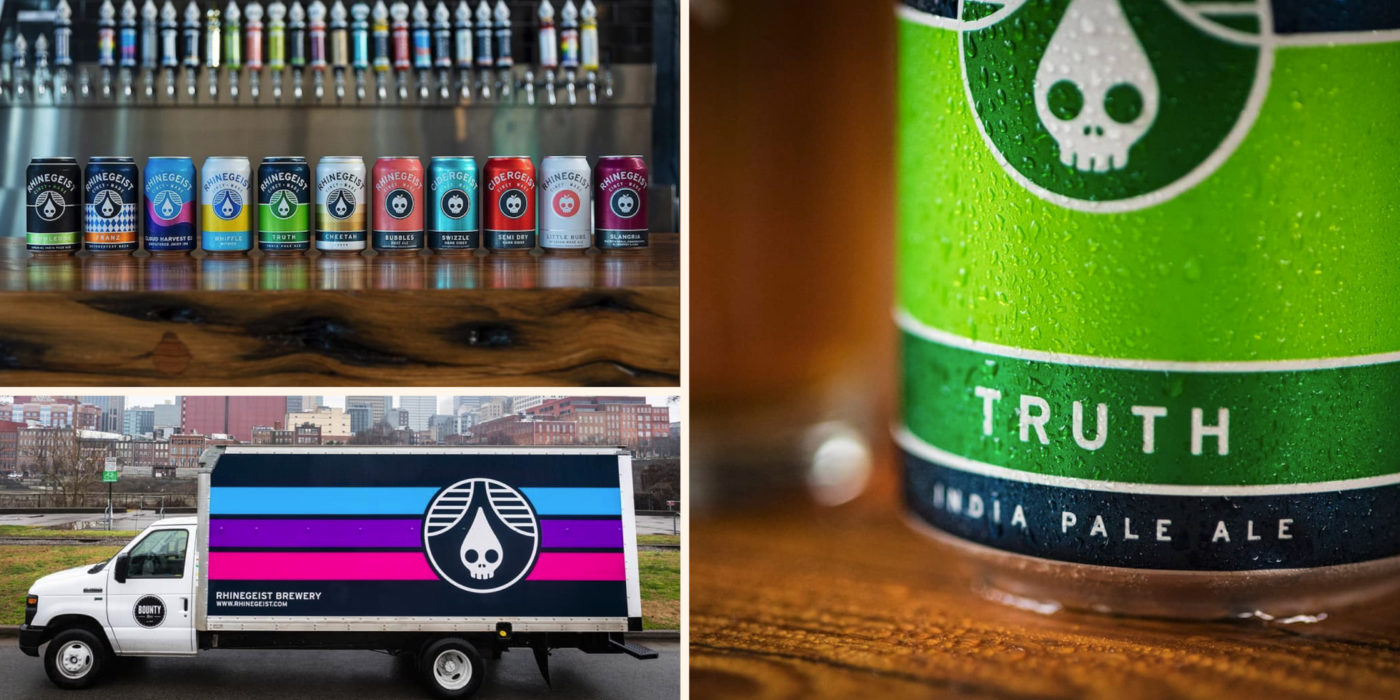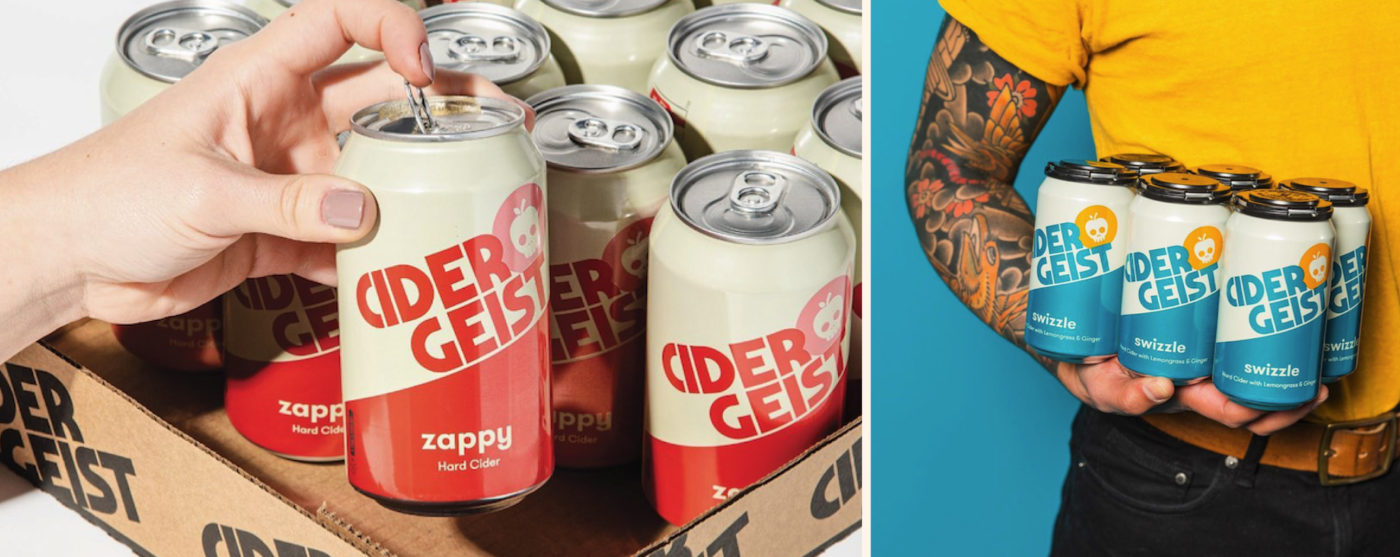***
A version of this conversation appeared in our Beer Branding Trends Newsletter. Subscribe for monthly tips on how to make better branding decisions and sell more beer.
***
Resources
How Rhinegeist Brewery Built a World Class Brand with an In-House Agency
And why your brewery should consider building an in-house team as well
Rhinegeist Brewery opened its doors in 2013 and has grown to become the 26th largest brewery in the United States. With 8,300+ breweries now open across the US, it’s doubtful that we’ll ever see a brewery open and grow to this scale again. (though I’d love to be proven wrong).
To reach this rarefied air, a brewery has to get everything right. The beer has to be phenomenal, the marketing and sales need to work in lockstep and the behind the scenes financials and business itself needs to be perfectly run. And perhaps most importantly, this would never happen without world class branding.
It may seem counterintuitive for a branding firm to tell you that your brewery should consider building an in-house design and marketing team, but CODO has made this very suggestion to dozens of growing breweries.
If you’re investing heavily in a rebrand, for instance, an in-house team is a great way to protect this investment. A well run, internal team keeps your messaging timely and consistent and can shape the overall brand and customer experience on an ongoing basis.
I’m excited to talk with Greg Althoff, Creative Director of Rhinegeist Brewery about this very topic. Greg oversees a small team at Rhinegeist.
We discuss his role as Creative Director, how to set goals as an in-house team, how his team collaborates with the other groups within Rhinegeist as well as one of my favorite topics—how can a brewery stay relevant and exciting while it continues to scale.


Hey Greg. Please introduce yourself and tell everyone what you do at Rhinegeist Brewery.
 Greg
Greg
I’m the creative director at Rhinegeist Brewery, and primarily, I lead design for a variety of projects from concept through production. I collaborate with the founders and senior leadership on planning and strategy for our business, identifying creative opportunities that push our brand forward.

Can you give us a run down on Rhinegeist—how old is the brewery, when was it founded, what kind of beers do you brew, annual bbl production and distribution footprint?
 Greg
Greg
Rhinegeist is coming up on eight years old, founded in 2013.
I think we’re really good at brewing great beer across a wide spectrum – everything from our sours and barrel aged programs to our flagship IPA, Truth, to something like Bubbles which more or less launched the Rosé trend. Our brewers want to be good at everything.
We get about 100k bbls out of a pretty small footprint – Ohio, Kentucky, Indiana, and parts of Pennsylvania, Tennessee and Wisconsin.
Even though we grew pretty quickly, I think we have a fairly sustainable, long-term view of our growth as a company.
As proof, the owners are going to begin the process of selling the company back to the employees next year. We’re trying to build a great company that people can be proud of which will be around for the long-haul.

What drew you to going in-house at Rhinegeist vs finding an agency gig?
 Greg
Greg
To put it simply, I was motivated to be more of a partner in the work and to give back what I had learned.
My favorite part of agency work was partnering with my clients, but as close as you can get, there’s always a gap. At the end of the project, it’s their business and I walk away. What you get in diversity and variety of work, you don’t get in ownership.
I also saw that there are thriving young companies who want to be more strategic in what they do, to build a brand that is beloved, but aren’t necessarily sure where to start.
The cool thing is that my co-workers aren’t clients, they’re partners. So, by virtue of that fact, design has a seat at the table and is an important consideration of what we do. And, in the same respect, the success of sales, production, company culture, etc is important to me as their partner.

We’ve seen a trend towards larger breweries (and across all CPG verticals) to build internal agencies. Can you give a quick rundown on this model and why you think it’s such an emergent trend?
 Greg
Greg
First, let’s assume a company’s “Brand” is its reputation with consumers. That reputation is formed by all stuff a company does, says and creates. “Design” is the process by which we make choices to influence all that stuff.
In his book The Brand Gap, Marty Neumeier estimated that Coke’s brand (or reputation) contributed $70 billion of value to the (then) $120 billion company. Basically, if they had sold white label products, the company would “only” be worth about $50 billion.
So, that’s incredible value. Companies like Coke and P&G understand this, and as craft breweries (large and small) mature, they are beginning to understand this as well.
Like any mission-critical asset, you want to own, not rent.
Having the people who eat, sleep, drink, breathe the brand day in and day out sit within the company means you have access to the means of production of one of your most valuable assets.
Now, that’s not to say that you can’t have a similar partnership with an external agency, and I think yours in particular does a really good job of providing that level of partnership. But the key is to find that partnership.

Build a stronger brand.
Sell more beer.
Join 7,500+ other beer industry folks and sign up for our monthly Beer Branding Trends Newsletter.

Beer Branding Trends 2.0

Give us a rundown of your creative department. How many designers, social media folks, etc. round out your team?
 Greg
Greg
Well, we have myself and the Marketing Director, three designers, two social media folks and two project managers. It’s probably a big team in context of the rest of the craft beer industry, but if you see brand as one of your most valuable assets as a business, it isn’t very large.

Did you name your creative team / department?
 Greg
Greg
You know, we haven’t. That’s not a bad idea!
I think, deep down, we want to be integrated with people whose jobs are very different from ours. At the end of the day, we’re all in service of the same mission – to draw attention to the really great stuff we do so that the company gets credit for what they do.

How does your agency set, review and measure goals?
 Greg
Greg
We have our yearly goals, our things we want to do, our products we want to launch successfully, like any business.
But I think what makes us different is that the company really emphasizes that we should behave like owners of the company in our roles. This is backed up by the fact that, starting next year, we’ll start the financial process to literally become owners of the company through our ESOP program.
So, a lot of our goal-setting comes from treating the team like fellow co-owners and giving them a voice help us drive where we should go as a creative team, a company and a brand.
TLDR: Hire really smart, talented people and let them tell us what to do.

We’re coming off of one hell of a year for breweries. How did your role as a creative director shift as the country wrestled with Covid?
 Greg
Greg
As a creative team, we were really firing on all cylinders toward the end of last year. I distinctly remember thinking “Ok, we’re really where we want to be, what now?”
And then March rolled around and said “This.”
Our marketing team has been 100% remote since March. The thinking behind this is that the more people we have at the brewery, the more risk that introduces, and threatens the viability of the company. If creatives get sick, we might have to say no to a project. If brewers and warehouse workers get sick, we can’t make beer.
My challenge has been to keep my team in a position to maintain our level of contribution through this time – over video calls from our attics, bedrooms, basements, etc.
Socially, it’s been a real challenge. We’re all here because we feed off each other. So we look for ways to keep that connection alive.
We’re really really picky about who we bring onto our team. We look for people with an ownership mentality, who act like part-owners of the company. The kind of people who can drive through adversity and ambiguity.
We’ve done some of the best work that we’ve ever done during this period, for no other reason than we just have really great, great people on our team.
But I think we’re all ready for this to be over.

What challenges do you face as creative director for one of the largest craft breweries in the country?
 Greg
Greg
As recently as three years ago, the role of “marketing” at a brewery like Rhinegeist was to make really cool label art, merch and parties and share it on social media. The consumers would then follow.
I think the biggest challenge is how we can shift from an era of easy, organic category growth into an era where demand is something that marketing is responsible for creating for our products.
The category is starting to evolve into a more traditional CPG category. Well, there are reasons why big CPG brands invest in things like advertising and sponsorships and things of that nature, because they create demand for their products.
How do you evolve in that direction without losing your soul?

Are you involved in developing new beer releases / names from a branding standpoint or are those lobbed over the wall by the brewing staff?
 Greg
Greg
We actually have a naming committee made up of employees from all over the brewery. They meet every week to brainstorm names for our upcoming releases.
Their output makes its way to us, where we vet it and run it through the filter of what we think will make the most compelling brand going forward.
We have a lot of really creative, smart people across all functions in the brewery, and as much as possible we really want to channel that creativity into our final product.

When I think of Rhinegeist, I don’t think you as an Ohio brewery. I think that’s one of the reasons your brewery’s branding has been so successful. Can you speak to the idea of building a world class brand, regardless of location versus hanging your hat on being local? Are there any pros/cons to this approach?
 Greg
Greg
Almost every can we release has “Cincy Made” on it for a reason. We’re fiercely proud of where we’re from and want everyone to know about the great things that are happening right here in Cincinnati.
That’s an important defining factor. Where we are from is an important part of who we are, but it isn’t all we are.
We want to be a brewery that can be respected anywhere that also happens to be from Cincinnati.

Your team recently revamped the Cidergeist branding and packaging. Can you give us a run down on what problems your were trying to solve and how this extension plays with the rest of the Rhinegeist portfolio?
 Greg
Greg
The business objective was to delineate the ciders from our fruited beers like Bubbles and allow them some room to stand out on their own in a space that isn’t as crowded as “craft beer” proper.
We felt like there is space for a robust, design-forward Cider brand with a stronger point of view than how Cidergeist was previously coming to life. The work is bold and has a strong point of view. It stands on its own, but feels appropriately tied back to our master brand.

We frequently work with regional breweries who are thinking about how to stay relevant as they scale and mature. A few common options we hear are to double down on your local market and drive growth through innovation (new products, categories) or, expand your distribution footprint (going a mile wide and an inch deep). How does Rhinegeist think about this?
 Greg
Greg
Well, like I mentioned previously, a lot of our strategy is based on being super deep in a pretty small footprint. I would venture to guess that we get 100k barrels out of fewer markets than most breweries.
Brand is about having a reputation that precedes you. The farther you go away from home, the less of a reputation you have. So you’re at the mercy of people who may or may not know much about you. You’re on the conveyor belt of new brands coming into markets.
That means you have to work harder and harder to get more out of your closer markets. You do that with innovation, you do that by delighting your consumers. You do that by working like hell to remind them why your biggest brands are still awesome.
Think of it like being in a long-term relationship. You gotta take your partner out to dinner every now and then. And you can’t just take them to Olive Garden every time, you gotta try that new tapas place or something. But you gotta mow the yard when you get home, too.

Historically, marketing has been viewed as a thing you bring in at the end to move a product—something you need to begrudgingly spend money on. Tell me why that’s wrong and how you view marketing’s role in running a successful brewery.
 Greg
Greg
It’s really easy to draw a line between sales and production and profit. A new fermenter will cost $X and deliver $10X in revenue. A new salesperson will deliver $3X of their salary. So on and so forth.
If you embrace the Coke example above (and I think the smart breweries will), that there is this thing called Brand (your reputational value), that Brand is one of the most valuable assets for your company and that you can make it more valuable, then investing in marketing isn’t such a crazy thing after all.
Just because it’s an intangible thing doesn’t mean it isn’t real. You get a Brand whether you like it or not. Whether you choose to influence it or not is the choice you make.
Plain and simple, the category is shifting from easy, organic growth to one where demand is created for its products and the way you do that is with marketing. The free ride is over.

Why is it so important for a brewery to frame (and live by) its brand values?
 Greg
Greg
The reason it’s important for you as a person to know what your values are: Are you a win-at-all costs kind of person or do you want to find wins for everyone? Do you want to have a career where you work 90 hours a week or is it important to see your kids at dinner every night? Just like the examples above, knowing your values as an organization will help you make decisions about what you want to do and where you want to go.

How does a large, regional brewery stay relevant in 2020 and beyond?
 Greg
Greg
I think it’s really important for breweries to understand what makes them actually distinctive in the grand scheme of things.
You will not be a better version of the AB Craft Portfolio. They are really good at that way of selling beer and have resources that you just can’t have.
You stay relevant by remembering why people were drawn to you in the first place. To take risks, to do interesting things, to be in love with making great beer. To be relatable, to be human in what you do. To make the communities you’re in better places to be.

Any book / podcast / website recommendations for in-house creative folks at breweries?
 Greg
Greg
I’m going to assume that you’re pretty locked in on how to deliver great work. Push yourself to understand the business, what creative strategy is and how decisions get made. Read about consumers so you can have empathy for them and what their lives are like. Read about what your friends in other parts of the brewery struggle with so you can help them be successful.

Beyond those, how do you stay sharp and up-to-date on emergent trends?
 Greg
Greg
Creative people should dedicate time every week to seeking out inspiration. You gotta treat it like a job, because, well, it’s your job. So that means knowing your go-to online resources, but also knowing when to go for a walk to clear your head.

We believe good design is good business. What have you seen, or directly influenced at Rhinegeist, that backs up this claim?
 Greg
Greg
We’ve had a really well-designed distinctive brand from the day we opened, which is a credit to our founders and their vision. Like I mentioned before, we invest pretty heavily in design and brand vis a vis the rest of the category and I think the result is that you can see passion in all the work we do.

What project are you most proud of, to date?
 Greg
Greg
I’m probably most proud of our redesign of the Barrel Aged series, because we wanted world-class design and we delivered it. We fought for that project, so to see it turn into really disruptive work is particularly gratifying. It’s a great symbol of the quality of the team we have at Rhinegeist.

Do you have any advice for breweries out there who may be thinking about building an in house team?
 Greg
Greg
Hiring creative people does no good if you don’t set them up to be successful. Then you’re just wasting your money.
I think strong creative leadership matters. You can’t just hire a kid straight out of college then beat the crap out of him/her and expect to have really good work that builds your brand. It costs money.
Creative people are some of the most wonderful people you could have in your organization. They are comfortable with ambiguity and love to think about what the future can be. Then they can make it happen.
Getting value out of the contributions of creative people can be one of the best things you do for your company.

Build a stronger brand.
Sell more beer.
Join 7,500+ other beer industry folks and sign up for our monthly Beer Branding Trends Newsletter.




